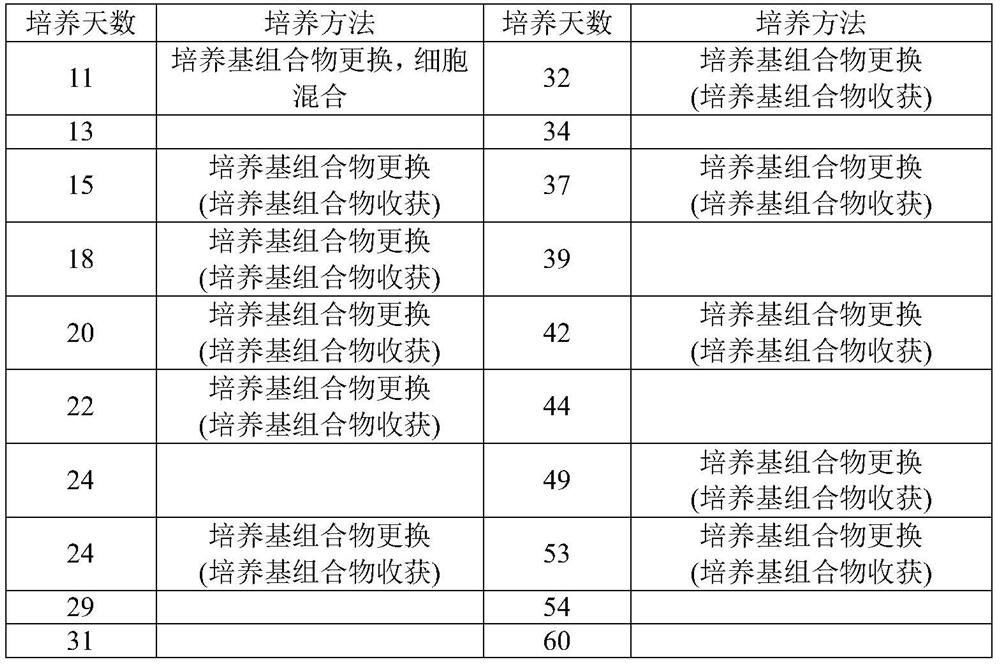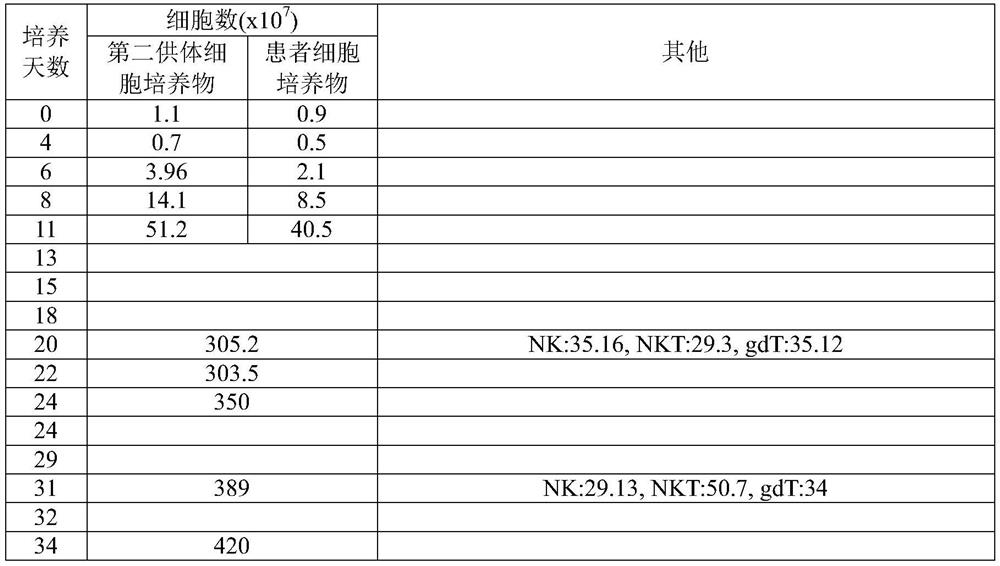Method for culturing allogeneic immune cell, immune cell culture obtained thereby, and immune cell therapeutic agent comprising same
A technology of immune cell therapy and immune cells, which is applied in the field of cultivating natural killer cells used in immunotherapy, can solve the problems of expensive and complicated culture process, and achieve the effect of prolonging cell life and improving cell proliferation
- Summary
- Abstract
- Description
- Claims
- Application Information
AI Technical Summary
Problems solved by technology
Method used
Image
Examples
Embodiment 1
[0059] The first method of culturing allogeneic immune cells was performed as follows.
[0060] 1. Steps for Obtaining the First Donor Cell Culture
[0061]First, using the characteristic that the specific gravity of mononuclear cells such as human lymphocytes or monocytes is lower than 1.077, the blood of a healthy donor is superimposed on the Ficoll-Paque Plus solution with a specific gravity of 1.077, so as to use a constant centrifugal force for centrifugal precipitation . Thus, separation was performed based on the difference in specific gravity so that the layer of erythrocytes and granulocytes with a specific gravity greater than 1.077 was at the bottom, and the layer of mononuclear cells and platelets with a specific gravity of 1.077 or less were at the top, thereby obtaining PBMCs containing lymphocytes. Only lymphocytes from PBMCs can be extracted and used if necessary. However, the same results can be obtained even when PBMCs are cultured without any modification,...
Embodiment 2
[0070] After the first mixed culture was obtained in the same manner as in Example 1, culture was carried out for 60 days while changing and harvesting the medium composition in the same manner as in Table 1 below, except that the donor was changed blood and patient blood, thereby obtaining a large number of culture medium compositions.
[0071] On day 11, the cells in the two bags were mixed with each other, then divided into two bags, and then cultured. In addition, the stimuli were changed while changing the concentration of cytokines in the medium at intervals of 3 to 4 days, and culture was performed while changing the medium. The change of cytokine concentration can be carried out by repeating the process of the 8th to 14th day of the NKTM culture method. That is, after culturing in a high-concentration C1 solution, culture is performed using a culture bag that does not contain cytokines, and the concentration of cytokines can be changed by gradually loosening the cultu...
Embodiment 3
[0075] A second method of culturing allogeneic immune cells proceeds as follows.
[0076] 1. Steps to Obtain a Second Donor Cell Culture
[0077] PBMCs isolated from the blood of another donor in the same manner as in Example 1 were cultured according to the NKTM culture method from day 0 to day 1 to obtain a second donor cell culture. The number of immune cells is 1.2×10 7 .
[0078] 2. Steps for preparing patient-derived PBMCs
[0079] PBMCs isolated from the blood of a patient to be administered an immune cell therapeutic agent were cultured from day 0 to day 14 according to the NKTM culture method to obtain a patient cell culture.
[0080] 3. Steps to Obtain a Second Mixed Culture
[0081] According to the NKTM culture method, add the patient cell culture instead of D unit to the second donor cell culture on day 2, so that the number of immune cells is 0.8×10 7 , thereby obtaining a second mixed culture.
[0082] 4. Mixed culture step
[0083] The second mixed cultu...
PUM
 Login to View More
Login to View More Abstract
Description
Claims
Application Information
 Login to View More
Login to View More - R&D
- Intellectual Property
- Life Sciences
- Materials
- Tech Scout
- Unparalleled Data Quality
- Higher Quality Content
- 60% Fewer Hallucinations
Browse by: Latest US Patents, China's latest patents, Technical Efficacy Thesaurus, Application Domain, Technology Topic, Popular Technical Reports.
© 2025 PatSnap. All rights reserved.Legal|Privacy policy|Modern Slavery Act Transparency Statement|Sitemap|About US| Contact US: help@patsnap.com



